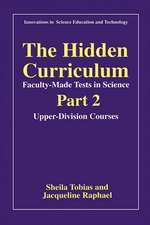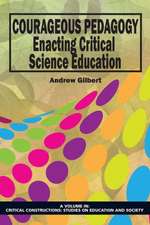Models and Modeling: Cognitive Tools for Scientific Enquiry: Models and Modeling in Science Education, cartea 6
Editat de Myint Swe Khine, Issa M. Salehen Limba Engleză Paperback – 21 apr 2013
| Toate formatele și edițiile | Preț | Express |
|---|---|---|
| Paperback (1) | 640.55 lei 3-5 săpt. | |
| SPRINGER NETHERLANDS – 21 apr 2013 | 640.55 lei 3-5 săpt. | |
| Hardback (1) | 647.40 lei 6-8 săpt. | |
| SPRINGER NETHERLANDS – 11 mar 2011 | 647.40 lei 6-8 săpt. |
Preț: 640.55 lei
Preț vechi: 753.60 lei
-15% Nou
Puncte Express: 961
Preț estimativ în valută:
122.56€ • 127.98$ • 101.21£
122.56€ • 127.98$ • 101.21£
Carte disponibilă
Livrare economică 25 martie-08 aprilie
Preluare comenzi: 021 569.72.76
Specificații
ISBN-13: 9789400735484
ISBN-10: 9400735480
Pagini: 300
Ilustrații: VIII, 292 p.
Dimensiuni: 155 x 235 x 16 mm
Greutate: 0.42 kg
Ediția:2011
Editura: SPRINGER NETHERLANDS
Colecția Springer
Seria Models and Modeling in Science Education
Locul publicării:Dordrecht, Netherlands
ISBN-10: 9400735480
Pagini: 300
Ilustrații: VIII, 292 p.
Dimensiuni: 155 x 235 x 16 mm
Greutate: 0.42 kg
Ediția:2011
Editura: SPRINGER NETHERLANDS
Colecția Springer
Seria Models and Modeling in Science Education
Locul publicării:Dordrecht, Netherlands
Public țintă
ResearchCuprins
PART I - Theory Formation and Modeling in Science Education.- Chapter 1. Modeling and the Future of Science Learning, Richard K. Coll, Denis Laijum.- Chapter 2. A Study of Expert Theory Formation: The Role of Different Model Types and Domain Frameworks, Allan Collins.-Chapter 3. The Nature of Scientific Meta-Knowledge, Barbara Y. White, Allan Collins, John R. Frederiksen.- Chapter 4. From Modeling Schemata to the Profiling Schema: Modeling across the Curricula for Profile Shaping Education, Ibrahim A. Halloun. - PART II – Modeling and Student Learning in Science Education.- Chapter 5. Helping Students Construct Robust Conceptual Models, Colleen Megowan-Romanowicz.- Chapter 6. The Molecular Workbench Software: An Innovative Dynamic Modeling Tool for Nanoscience Education, Charles Xie, Amy Pallant .- Chapter 7. Lowering the Learning Threshold: Multi-Agent-Based Models and Learning Electricity, Pratim Sengupta, Uri Wilensky.- Chapter 8. Engineering-based Modeling Experiences in the Elementary and Middle Classroom, Lyn D. English, Nicholas G. Mousoulides.- Chapter 9. Engaging Elementary Students in Scientific Modeling: The MoDeLS 5th Grade Approach and Findings, Hamin Baek, Christina Schwarz, Jing Chen, Hayat Hokayem, Li Zhan.- PART III – Modeling and Teachers’ Knowledge.- Chapter 10. Relationships between Elementary Teachers’ Conceptions of Scientific Modeling and the Nature of Science, Valarie L. Akerson, Orvil White, Huseyin Colak,Khemmawaddee Pongsanon.- Chapter 11. Science teachers’ knowledge about learning and teaching models and modeling in Public Understanding of Science, Ineke Henze, Jan H. van Driel.- Chapter 12. Teaching Pre-serviceElementary Teachers to Teach Science with Computer Models, Nicos Valanides, Charoula Angeli.- Subject Index.
Textul de pe ultima copertă
The process of developing models, known as modeling, allows scientists to visualize difficult concepts, explain complex phenomena and clarify intricate theories. In recent years, science educators have greatly increased their use of modeling in teaching, especially real-time dynamic modeling, which is central to a scientific investigation. Modeling in science teaching is being used in an array of fields, everything from primary sciences to tertiary chemistry to college physics, and it is sure to play an increasing role in the future of education.
Models and Modeling: Cognitive Tools for Scientific Enquiry is a comprehensive introduction to the use of models and modeling in science education. It identifies and describes many different modeling tools and presents recent applications of modeling as a cognitive tool for scientific enquiry.
The processes of modelling and the use of the resulting models to inform predictions play key roles in the nature of science and hence in science education, especially in inquiry-based approaches. Against a background of the philosophical basis for modelling and models, the implications for science education are explored. Well-designed and thoroughly classroom-tested schemes to support students in learning how to model are reviewed. Research into teachers’ understanding of models and their place in the nature of science are reviewed as are successful strategies for the further development of that knowledge. This book has a major contribution to make to the pre- and in-service education of elementary (primary) and high (secondary) school science teachers.
John K. Gilbert
Professor Emeritus, The University of Reading
Visiting Professor, King's College London
Editor-in-Chief, International Journal of ScienceEducation
Models and Modeling: Cognitive Tools for Scientific Enquiry is a comprehensive introduction to the use of models and modeling in science education. It identifies and describes many different modeling tools and presents recent applications of modeling as a cognitive tool for scientific enquiry.
The processes of modelling and the use of the resulting models to inform predictions play key roles in the nature of science and hence in science education, especially in inquiry-based approaches. Against a background of the philosophical basis for modelling and models, the implications for science education are explored. Well-designed and thoroughly classroom-tested schemes to support students in learning how to model are reviewed. Research into teachers’ understanding of models and their place in the nature of science are reviewed as are successful strategies for the further development of that knowledge. This book has a major contribution to make to the pre- and in-service education of elementary (primary) and high (secondary) school science teachers.
John K. Gilbert
Professor Emeritus, The University of Reading
Visiting Professor, King's College London
Editor-in-Chief, International Journal of ScienceEducation
Caracteristici
Comprehensive introduction to the use of models and modeling in science education Focuses explicitly on enhancing science learning Examines the most up-to-date and contemporary research efforts Explores concepts that are vital to the understanding of science teaching



































